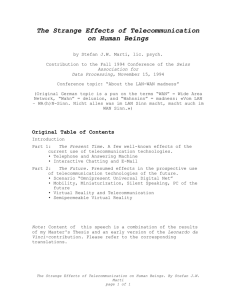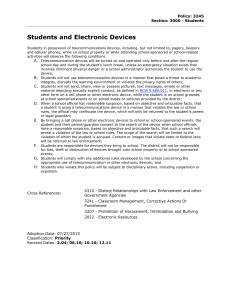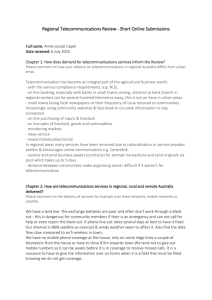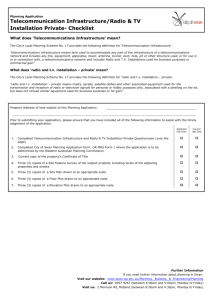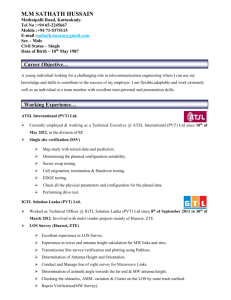Advertising and Consumer Choice of Telecommunication Services
advertisement
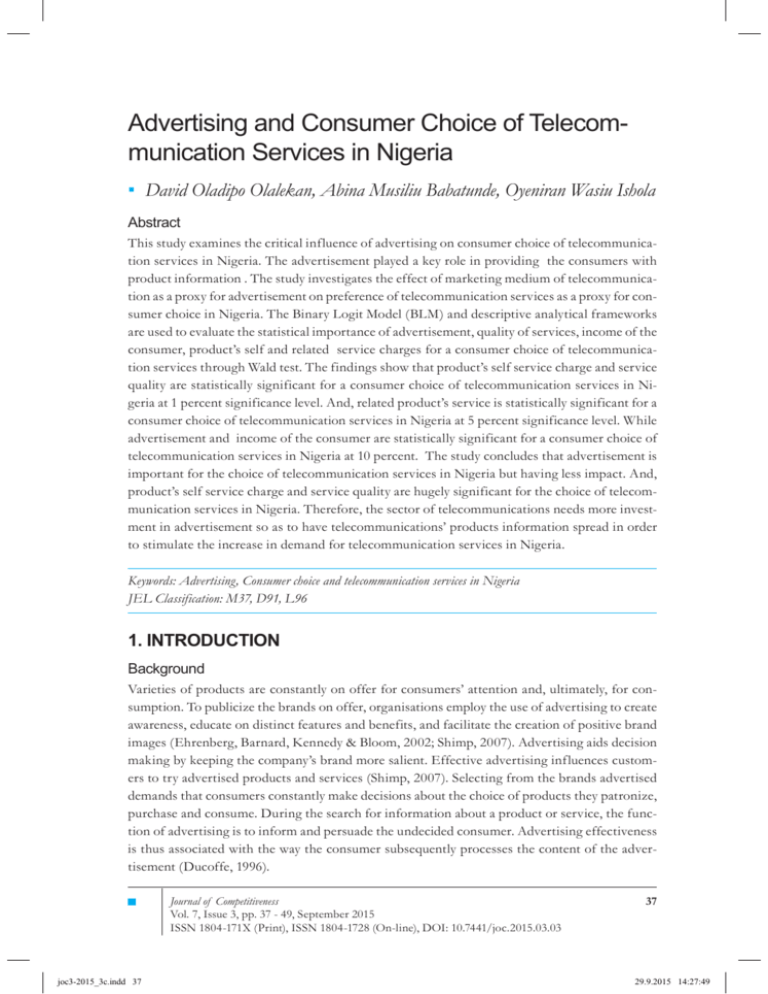
Advertising and Consumer Choice of Telecommunication Services in Nigeria
▪ David Oladipo Olalekan, Abina Musiliu Babatunde, Oyeniran Wasiu Ishola
Abstract
This study examines the critical influence of advertising on consumer choice of telecommunication services in Nigeria. The advertisement played a key role in providing the consumers with
product information . The study investigates the effect of marketing medium of telecommunication as a proxy for advertisement on preference of telecommunication services as a proxy for consumer choice in Nigeria. The Binary Logit Model (BLM) and descriptive analytical frameworks
are used to evaluate the statistical importance of advertisement, quality of services, income of the
consumer, product’s self and related service charges for a consumer choice of telecommunication services through Wald test. The findings show that product’s self service charge and service
quality are statistically significant for a consumer choice of telecommunication services in Nigeria at 1 percent significance level. And, related product’s service is statistically significant for a
consumer choice of telecommunication services in Nigeria at 5 percent significance level. While
advertisement and income of the consumer are statistically significant for a consumer choice of
telecommunication services in Nigeria at 10 percent. The study concludes that advertisement is
important for the choice of telecommunication services in Nigeria but having less impact. And,
product’s self service charge and service quality are hugely significant for the choice of telecommunication services in Nigeria. Therefore, the sector of telecommunications needs more investment in advertisement so as to have telecommunications’ products information spread in order
to stimulate the increase in demand for telecommunication services in Nigeria.
Keywords: Advertising, Consumer choice and telecommunication services in Nigeria
JEL Classification: M37, D91, L96
1. INTRODUCTION
Background
Varieties of products are constantly on offer for consumers’ attention and, ultimately, for consumption. To publicize the brands on offer, organisations employ the use of advertising to create
awareness, educate on distinct features and benefits, and facilitate the creation of positive brand
images (Ehrenberg, Barnard, Kennedy & Bloom, 2002; Shimp, 2007). Advertising aids decision
making by keeping the company’s brand more salient. Effective advertising influences customers to try advertised products and services (Shimp, 2007). Selecting from the brands advertised
demands that consumers constantly make decisions about the choice of products they patronize,
purchase and consume. During the search for information about a product or service, the function of advertising is to inform and persuade the undecided consumer. Advertising effectiveness
is thus associated with the way the consumer subsequently processes the content of the advertisement (Ducoffe, 1996).
Journal of Competitiveness
Vol. 7, Issue 3, pp. 37 - 49, September 2015
ISSN 1804-171X (Print), ISSN 1804-1728 (On-line), DOI: 10.7441/joc.2015.03.03
joc3-2015_3c.indd 37
37
29.9.2015 14:27:49
Tracing the impact of advertising on consumer choice offers two substantial advantages. First,
it allows access to a large selection of naturally occurring stimuli. Second, it offers a natural observable consequence of successful persuasion, namely, the choice of advertised product (Russo
& Chaxel, 2010). Although, advertising effectiveness is measured through the resulting attitude
towards the product advertised, choice is used in this study to assess the primary role advertising
plays in consumer’s decision among competing range of options.
That advertising can influence product purchase is well established (e.g. Ailawady & Neslin,
1998; Tellis, Chandy & Thaivanich, 2000). Empirical studies on how advertising works are also
numerous (e.g. Hoch & Ha, 1986). Much literature examines how consumers process information about available offers on the market and make choices from among these options in relevant
choice situations (Ehrenberg et al., 2002), and, thereby, increase the likelihood of purchasing
brands that otherwise might not be chosen (Machleit, Allen & Madden, 1993). However, to our
knowledge, there is no existing study on the relationship and interaction of advertising and consumer choice in the context of telecommunication services in Nigeria.
Research Problems
Past studies on consumer choice have focused on several factors that influence decision making.
The studies have examined the influence of price presentation order on consumer choice(Suk,
Lee, & Lichtenstein, 2012), television advertising and branding effect on eating behavior and
preferences (Boyland & Halford, 2012), the influence of online product recommendations on
consumers’ online choices (Senecala & Nantel, 2004), sensory aspect of consumer choices (Resurreccion, 2003),and the influence of structural alignment on choices among a set of options
such as comparative advertising (Markman, & Loewenstein, 2010).
The relationships between product information and consumer behavior in terms of perceptions
of various telecommunication services and how these perceptions are associated with final purchase decision making have not previously been studied. For those reasons, the present study
was designed to examine the influence of advertising on consumer choice with particular focus
on telecommunications services in Nigeria.
Objectives of the Study
1. to identify the determinants of the consumers’ choice of telecommunication services in
Nigeria
2. to examine if advertising influences the choice of telecommunications services patronised
by consumers.
3. to investigate if advertising motivates consumers to consider purchase of a particular telecommunications brand.
2. LITERATURE REVIEW
Conceptual
Advertising is paid-for communication to more than one person, intended to inform or change
behaviour (Broadbent, 2001). It is a mediated form of communication from an identifiable
38
joc3-2015_3c.indd 38
Journal of Competitiveness
29.9.2015 14:27:49
source, designed to persuade the receiver to take some action, now or in the future (Richards &
Curran, 2002). Advertising is a key element of the promotional activity which has become the
undisputed spokesman of modern marketing which is characterised by centralized and mass
production, differentiated and branded products, widely dispersed and sophisticated consumers
(Onyenyili-Onuorah, 2005). As espoused by Keller (2008), it is a powerful means of creating
strong, favourable, and unique brand associations and eliciting positive judgements and feelings.
In a free society, advertising is an important tool in the competition which is the invisible hand
guiding production (McDonald, 1992). As products are produced and introduced into the market, advertising helps get the new product off the ground by giving more people more “complete
information” thereby stimulating primary demand for the entire product class. Furthermore,
it has the potential to influence selective demand for a particular brand (Arens, 2002).Consequently, the effect on consumer demand sets off a chain reaction and, thus, affects consumer
choice. The freedom to advertise promotes the existence of more sellers, and that gives consumers wider choices (Arens, 2002).
Choice presupposes the existence of alternative courses of action. It also implies access or ability
to follow any of the available courses of action without hindrance. Quality of individual choices
is usually influenced by information about the available options. The extent and quality of choice
which consumers exercise in the economy will be greatly affected by the scope of advertising in
operation in that economy. Advertising messages, like all marketing communication messages,
are directed toward influencing consumers’ brand-related beliefs, attitudes, emotional reactions,
and choices (Shimp, 2007). Advertising enhance the extent and quality of choices that consumers make by providing regular and quality information on available products and their uses.
However, in some respects, it tends to limit the scope of consumer choice especially in situations
where only few of several alternative products are advertised and given prominence over other
alternatives (Onyenyili-Onuorah, 2005).
Theoretical Framework
A number of models have been developed to describe the consumer decision making process
and consumer behaviour. The study of consumer behaviour is generally divided into two different approaches: the consumer processing model (CPM) and the hedonic and experiential model
(HEM). Consumer-processing model (CPM) and Hedonic experiential model (HEM) explains
how consumers make decisions about their choices. From the consumer-processing perspective (CPM), information processing and choice are seen as rational, cognitive, systematic, and
reasoned (Leigh & Martin, 1990).This in tandem with the views of traditional economist who
postulated that demand is based on product own price, relative price, income of the consumer
and taste (Marshall, 1920).The consumer is constantly bombarded with information which is
potentially relevant for making choices. The consumer’s reactions to that information, how that
information is interpreted, and how it is combined or integrated with other information may
have crucial impacts on choice (Bettman, 1979). With the consumer processing model, consumer
behaviour is highly cognitive, rational, systematic, and reasoned. Hence, advertisement decisions
must be developed and integrated into how consumers make choices.
39
joc3-2015_3c.indd 39
29.9.2015 14:27:49
The hedonic, experiential perspective (HEM), on the other hand, views consumer processing of
communication messages and behaviour as driven by emotions in pursuit of fun, fantasies, and
feelings (Hirschman & Holbrook, 1982).Advancing the HEM, Shimp (2007) adds that the HEM
viewpoint recognizes that people often consume products for the sheer fun of it or in the pursuit
of amusement, fantasies, or having pleasurable feelings.
Dawson, Bloch, and Ridgway (1990) contend that consumers are motivated by three broad categories of needs that are (a) utilitarian or product-related, (b) hedonic or recreational, and (c) a
combination of both utilitarian and hedonic. In trying to satisfy these needs, consumers process
advertising information and ultimately use this information to choose from among the alternatives available in the marketplace.
Many empirically important economic decisions involve choice among discrete alternatives
(McFadden, 1978). The Classical economist (Marshal, 1920) opined that choice of consumption
of any commodity (product) is solely determined by the price of the product, price of related
products, income of the consumer and taste of the consumer, though, there are other factors
that determine consumer’s choice. He assumed further that there is existence of perfect flow of
information (advertisement) in the market that equip the consumers in order to make appropriate decisions and choices.
Empirical Studies
Much research of advertising has been conducted into consumer choice (Markman & Loewenstein, 2010; DiClemente & Hantula, 2003). This study is particularly appropriate given the constant and repetitive advertising of telecommunications services. The question arises as to the effect of this promotional activity on consumer choice of telecommunication services in Nigeria.
We found only one study that examined the influence of a persuasive message (advertising) effects on consumer choice (Russo & Chaxel, 2010).The study employed an experimental design
consisting of 203 participants divided and placed under five conditions; two uncontrolled and
three controlled; in verifying the ability of a specific, observable process to explain the influence of a persuasive message on choice. The study indicated that although people are aware of
advertising’s direct effect on their choice, they are not aware of its indirect effect through biased
evaluation of the product information.
In another study, Boyland and Halford (2012) examined the question of whether television advertising and branding had an effect on choice of food. However, the study was not limited to
choice only; it also examined effects on eating behaviour. From their research, they concluded
that the impact of advertising and branding on children is readily demonstrated by their brand
recognition, and its influence on food choice.
3. METHODOLOGY AND MODEL
Rationale for this study’s model lies in the consumer behaviour theory as emphasised in literatures (Marshall, 1920; Russo & Chaxel, 2010; Boyland & Halford 2012). Thus, the study employed a Binary Logit Model (BLM) method of estimation due to categorical response nature of
research target variable that telecommunication consumers in Nigeria preferred other network
40
joc3-2015_3c.indd 40
Journal of Competitiveness
29.9.2015 14:27:49
provider to be the market leader to otherwise (MTN) i.e. If Preferred, 1 and 0 if otherwise. The
consumer choice of telecommunication services of the respondents is captured by preference of
telecommunication services provider’s dominance.
Thus, the model is stated as
Pr i = E(Tchi = 1/ Mi) = β 0 + βi Mi + Ui
(3.1)
Where Mi is the vector of telecommunication market information spread indicators of Telecommunication operators and Tch = l means customers of telecommunication services preferred
other network provider to be the market dominant with respect to MTN and Zero (0) if otherwise. Further, M i = f(Ici, Adv i, Pch i, Ca i, Qch i) and can be Mathematically stated as
Mi = Ψ0 + Ψ1Ic i +Ψ2Advi + Ψ3Pchi + Ψ4Cai + Ψ5 Qchi + ei
(3.2)
But now let consider the following representation of preference of telecommunication services
by network providers in Nigeria from (3.1)
Pr i = E(Tchi = 1/ Mi) = 1
1 + e -(βo + βiMi + Ui)
(3.3)
Assume Zi = βo + βi Mi + Ui 1
1 + e-Zi
Thus; Pr i =
eZ
1 + eZi
=
(3.4)
Equation 3.4 represents the cumulative logistic distribution function, where Pr i ranges from 0
and1 and Zi ranges from - ∞ to + ∞.
If Pr i, is the probability of customers of telecommunication services preferred other network
provider to be the market dominant with respect to MTN in Nigeria then (1 - Pr i), is the probability of preference of MTN as market dominant.
Therefore, (1 - Pr i) = 1 – [
1 – Pr i =
eZi
1 + eZi
]
1
1 + eZi
(3.5)
(3.6)
The odd ratio of customers of telecommunication services preferred other network provider to
be the market dominant with respect to MTN in Nigeria is (3.4) divided by (3.6)
3UL H=L
3ULH
3UL H=L
,3UL
=L
H
=L
(3.7)
(3.8)
41
joc3-2015_3c.indd 41
29.9.2015 14:27:50
Taking the natural log of (3.8) to obtain the Liner Probability Model (LPM)
L
/ ,Q3U
,QH=L
L
3UL
3UL
=L
/L ,Q
3UL
/ = Ƣ Ƣ 0 8 L
L
R
L
L
L
(3.9)
Substitute (3.2) in (3.9)
Mi = Ψ0 + Ψ1Ic i +Ψ2Advi + Ψ3Pchi + Ψ4Cai + Ψ5Qchi + ei
L i = β 0 + β1 (Ψ0 + Ψ1Ic i +Ψ2Advi + Ψ3Pchi + Ψ4Cai + Ψ5Qchi + ei) + Ui
L i = β 0 + β1Ψ0 + β1Ψ1Ic i+ β1Ψ2Advi + β1Ψ3Pchi+ β1Ψ4Cai+ β1Ψ5Qchi + β1ei + Ui
Let Φ0= β 0 + β1 Ψ0, Φ1= β1Ψ1, Φ2= β1Ψ2, Φ3= β1Ψ3, Φ4= β1Ψ4, Φ5= β1Ψ5 and ε=β1ei + U
(3.10)
Therefore,
L i = Φ0 + Φ1Ic i + Φ2Advi + Φ3Pchi + Φ4Cai + Φ5 Qchi + εi
(3.11)
Where; Tch =Choice of Telecommunication services in Nigeria (Taking MTN as reference and most
preferred)
Ic = Income of the customers
Adv = Medium of advertisement
Pch = Cost of consuming preferred Telecommunication Network services
Ca = Cost of consuming competing Telecommunication Network services
Qch = Service Quality
The equation (3.11) is the Binary Logit Model (BLM) that estimates the Consumers’ Choice of
Telecommunication Services in Nigeria. The maximum likelihood (ML) technique aid estimation techniques in this study since ordinary least square (OLS) technique cannot be used to
estimate data at micro level i.e. discrete data.
Assumptions of the Model
1. Consumers are rational in service purchase
2. There is even access to market information
3. Telecommunication services are normal products
4. There are substitutes to the preferred network
Research Hypothesis
H0: Advertising does not have impact on consumers’ choice of telecommunication services in
Nigeria
H1: Advertising has impact on consumers’ choice of telecommunication services in Nigeria
42
joc3-2015_3c.indd 42
Journal of Competitiveness
29.9.2015 14:27:50
Tab. 3.1 - Summary of Dataset. Source: Authors, 2015.
Variable
Variable
Definition
Variables’ Proxy in
the Questionnaire
Tch
Choice of
Telecommunication services in
Nigeria (Taking
MTN as reference and most
preferred)
MTN Network being the Market leader
in the Telecom0 = No
munication sector
in Nigeria, would
1 = Yes
you prefer another
Network to be the
Market leader?
Ic
Income of the
customers
Average Monthly
Income
Code of Categorical Set
Source
of Data
Survey
1 = Less than N18,000
2 = N18,000 - N50,000
Survey
3 = More than N50,000
1 = Television
Adv
Medium of
advertisement
Main medium of advertisement for your
Telephone Network?
2 = Radio
3 = Newspapers/Journals
Survey
4 = Billboards/Handbills
5 = Other
Pch
Ca
Qch
Cost of consuming preferred
Telecommunication Network
services
How would you
describe the service
charge of your
Telephone Network
provider?
Cost of consuming competing
Telecommunication Network
services
If provided with better services by other
Network providers,
would you switch?
Service Quality
How would you rate
service quality of
your Telephone Network provider?
1 = Low
2 = Moderate
Survey
3 = High
1 = No
2 = Yes
Survey
1 = Poor
2 = Fair
3 = Good
Survey
4 = Excellent
43
joc3-2015_3c.indd 43
29.9.2015 14:27:50
Tab. 3.2 - A Priori Expectation of the Explanatory Variables. Source: Authors, 2015.
Variable
Variable Definition
Expected sign
Ic
Income of the customers
Positive (+)
Adv
Medium of advertisement
Positive (+)
Pch
Cost of consuming preferred Telecommunication Network services
Negative (-)
Ca
Cost of consuming competing Telecommunication Network services
Positive (+)
Qch
Service Quality
Positive (+)
Sample Survey and Scope
The study was conducted in Nigeria and the data used were gathered from the six (6) geo-political zones that made up Nigeria i.e. South-west, South-south, South-east, North-central, Northwest and North-east. This research work was carried out between September, 2014 and April,
2015 which is eight (8) months. The study employed structured questionnaire to elicit required
information from the subscribers of Telecommunications services providers in Nigeria through
online medium i.e. online questionnaire form powered by Google forms. The study administered 3,600 questionnaires which comprises of 600 questionnaires to each geo-political zone in
Nigeria but 3,458 questionnaires were returned. The response rate is 96 percent which is a fair
representation of the total number of administered questionnaires.
Methods of Estimation
From the data collected through questionnaire administration to the customers of the telecommunication services providers in Nigeria, the frequency count, mean and simple percentage are
used to classify the consumers of telecommunication services in Nigeria. Binary Logit analysis
through maximum likelihood estimation technique was used for the model. Analysis of variance (ANOVA) is validated through chi square (χ2) of the logit equation and Wald tests were
conducted to assess whether consumers with different socio-demographic characteristics have
different perceptions on the telecommunications market dominance preference.
4. DATA AND RESULTS
Telecommunication Operators’ Market share in Nigeria
Fig. 4.1 - Source: Author, 2015
44
joc3-2015_3c.indd 44
Journal of Competitiveness
29.9.2015 14:27:50
Figure 4.1 shows the extent of market penetration of the telecommunication services provider
in Nigeria and this captured through most used telecommunication network by the respondents.
The result shows that 50 percent of the respondents patronise MTN, 32 percent are use Glo
network often, 12 percent prefer Airtel while only 6 percent of the respondents subscribe to the
services of Etisalat. From figure 4.1, it is glaring that MTN dominates the telecommunication
market in Nigeria with control of half of the total market share.
Empirical Results
Tab. 4.1 - Binary Logit Estimates for Consumers’ Choice of Telecommunication Services in
Nigeria. Source: Researchers’ Computation, 2015.
Variable
Coefficient
Intercept
Ic
Adv
-0.344
3.717*
0.054
0.709
Pch
1.262
33.056***
0.000
3.534
Ca
-0.514
3.981**
0.046
0.598
0.811
13.275***
0.000
2.249
Qch
N = 3458
Wald ratio
p – value
-2.216
16.196
0.000
0.109
0.225
2.753*
0.097
1.253
Nagelkerke R 2= 0.907
Odds ratio
χ2 = 3943.093 (0.000)
Note: “***”, “**” and “*” indicated at least significance at 1%, 5% and 10% level.
Reference Category: Yes
Discussion of the Empirical Results
The Binary logit estimate for Consumers’ Choice of Telecommunication Services in Nigeria is
presented in table 4.1. The probability effects of the explanatory variables {Income of the customers (Ic), Medium of advertisement (Adv), Cost of consuming preferred Telecommunication
Network (Pch), Cost of consuming competing Telecommunication Network providers (Ca) and
Service Quality (Qch)} are determined by maximum likelihood techniques and satisfy the Independence of Irrelevant Alternatives (IIA) assumptions.
The empirical results show that Income of the customers (Ic) is directly related to Consumers’
choice of Telecommunication services in Nigeria and it this agrees with the economic a priori
expectation. The Medium of advertisement (Adv) is inversely associated with the Consumers’
choice of Telecommunication services in Nigeria but this negates the economic a priori expectation. The finding shows that the Cost of consuming preferred Telecommunication Network
(Pch) is directly related to the Consumers’ choice of Telecommunication services in Nigeria
which disagree with the economic a priori expectation. The Cost of consuming competing Telecommunication Network providers (Ca) is negatively related to Consumers’ choice of Telecommunication services in Nigeria and this conform with the economic a priori expectation. The
Service Quality (Qch) is directly associated with the Consumers’ choice of Telecommunication
services in Nigeria and this follow the economic a priori expectation.
45
joc3-2015_3c.indd 45
29.9.2015 14:27:50
The parameter estimates of the regressors {Income of the customers (Ic), Medium of advertisement (Adv), Cost of consuming preferred Telecommunication Network (Pch), Cost of consuming competing Telecommunication Network providers (Ca) and Service Quality (Qch)} show
the elasticity of Consumers’ choice of Telecommunication services in Nigeria. The results depict
that Income of the customers causes 22.5 percent increase in the Consumers’ choice of Telecommunication services in Nigeria. But, medium of advertisement causes 34.4 percent drop
in the Consumers’ choice of Telecommunication services in Nigeria. While, cost of consuming
preferred Telecommunication Network causes 126.2 percent rise in the Consumers’ choice of
Telecommunication services in Nigeria. The cost of consuming competing Telecommunication
Network providers causes 51.4 percent drop in the Consumers’ choice of Telecommunication
services in Nigeria. And, Service Quality increases the Consumers’ choice of Telecommunication services in Nigeria by 81.1 percent.
The Wald ratio test measures the individual regressors {Income of the customers (Ic), Medium of
advertisement (Adv), Cost of consuming preferred Telecommunication Network (Pch), Cost of
consuming competing Telecommunication Network providers (Ca) and Service Quality (Qch)}
significance to theregressand (Choice of Telecommunication services in Nigeria). The test reveals that Cost of consuming preferred Telecommunication Network and Service Quality are
statistically significant to the Consumers’ choice of Telecommunication services in Nigeria at
1 percent significance level. The cost of consuming competing Telecommunication Network
providers is statistically significant to the Consumers’ choice of Telecommunication services in
Nigeria at 5 percent but Income of the customers and Medium of advertisement are statistically
significant to the Consumers’ choice of Telecommunication services in Nigeria at 10 percent significance level. This implies that cost of consuming preferred Telecommunication Network and
Service Quality exert strong pressures on the Consumers’ choice of Telecommunication services
in Nigeria while the cost of consuming competing Telecommunication Network providers exert
moderate pressures on the Consumers’ choice of Telecommunication services in Nigeria. But,
Income of the customers and Medium of advertisement exert fair pressures on the Choice of
Telecommunication services in Nigeria.
The overall significance test of the regressors {income of the customers (Ic), medium of advertisement (Adv), cost of consuming preferred Telecommunication Network (Pch), cost of consuming competing Telecommunication Network providers (Ca) and service quality (Qch)} is
ascertained through the chi square test (χ2) . The test reveals that when all the parameter estimates of the explanatory variables are jointly measured in term of the statistical importance to
the regressand, the regressors are statistically significant to the Consumers’ choice of Telecommunication services in Nigeria at 1 percent significance level due to its p-value less than 0.01.
This result validates the alternative hypothesis (H1) of the study that advertising has impact on
consumers’ choice of telecommunication services in Nigeria.
The coefficient of determination tests the extent of variations in the consumers’ choice of telecommunication services in Nigeria caused by the deterministic components {Income of the
customers, Medium of advertisement, Cost of consuming preferred Telecommunication Network, Cost of consuming competing Telecommunication Network providers and Service Quality} and the stochastic component of the model. This is evaluated through the “Nagelkerke R
46
joc3-2015_3c.indd 46
Journal of Competitiveness
29.9.2015 14:27:50
Square” which shows a strong deterministic value of 0.907. This implies that about 90.7 percent
variations in consumers’ choice of telecommunication services in Nigeria are caused by Income
of the customers, medium of advertisement, cost of consuming preferred Telecommunication
Network, cost of consuming competing telecommunication network providers and service quality. But, the stochastic term caused about 9.3 percent variations in the consumers’ choice of
telecommunication services in Nigeria.
The Odd ratio measures the probability that Telecommunication consumers in Nigeria prefer other network provider to be the market leader to otherwise (MTN). The probability that
consumers prefer other networks with respect to advertisement and market information is 0.71
(approximately 1) to 1 in Nigeria. This implies that 1 out of 100 consumers have privilege of
influenced by advertisement of telecommunication services in Nigeria.
5. CONCLUSION AND RECOMMENDATIONS
Information played pivotal role in business progress in which Nigeria is not an exceptional. The
rate of Information spread is key to business efficiency from the perception of product production, exchange and consumption. The advent of telecommunications Liberalization fading
out direct business contact that have dominated business transactions from the era of Nigeria
post-independence. The spillover effect of Telecommunication service cannot be neglected in
the boom of gross output experienced in Nigeria from 2000 to date. The advertising of telecommunications services take different dimensions which have impacted greatly on the demand for
the telecommunications products, ranging from Telephone calls, SMS, internet services, etc in
Nigeria. Therefore, Marketing of telecommunications products have less significant impact on
choice of telecommunications demand in Nigeria. While, product’s self service charge and service quality exert high pressure on consumer choice of telecommunications services in Nigeria.
Thus, this study recommends that;
1. Telecommunications operator should invest meaningfully on advertisement as to make
their products well known to the consumers. Healthy advertisement policy should be put in
place for adequate marketing that will equip the consumer with needed market information
of the products and services of Telecommunications operators.
2. Service charge by telecommunication operators played a key role in the choice of telecommunication services. More Liberalization in the telecommunication industry market will
stimulate lower prices of services and increase the demand for telecommunications products.
3. Quality of service is a major determinant of choice of telecommunications services in Nigeria and the better the quality of services, the higher the level of patronage of their products. The regulatory body must ensure that Telecommunications operator provide quality
services that conform with international best practice.
4. Sufficient income for the consumer should be supported by the government, so as to raise
the standard of living through increase in individual personal expenditure that will influence consumers’ choice of telecommunication services.
47
joc3-2015_3c.indd 47
29.9.2015 14:27:50
References
1. Ailwady, K. L., & Neslin, S. A. (1998). The effect of promotion on consumption:
Buying more and consuming it faster. Journal of Marketing Research, 35(3), 390-398.
doi:10.2307/3152036
2. Arens, W. F. (2002). Contemporary advertising (Vol. 8.). New York: McGraw-Hill/Irwin.
3. Bettman, J. B. (1979). An information processing theory of consumer choice. Reading, Mass:
Addison-Wesley.
4. Boyland, E. J., & Halford, J. C. G. (2012). Television advertising and branding: Effects on
eating behavior and preferences in children. Appetite, retrieved from www.http://dx.doi.
org/10.1016/j.appet.2012.01.032
5. Broadbent, S. (2001). Advertising. In M. J. Baker (ed.). The IEBM encyclopedia of marketing.
London: International Thomson Business Press.
6. Dawson, S., Bloch, P. H., & Ridway, N. M. (1990). Shopping motives, emotional states, and
retail outcomes. Journal of Retailing, 66, 408-427.
7. DiClemente, D. A., & Hantula, D. F. (2003). Applied behavioral economics and consumer
choice. Journal of Economic Psycholog y, 24, 589-602. doi:10.1016/s0167-4870(03)00003-5
8. Ducoffe R. H. (1996). Advertising value and advertising on the web. Journal of Advertising
Research, 36(5), 21–35.
9. Ehrenberg, A., Barnard, N., Kennedy, R., & Bloom, H. (2002). Brand advertising as
creative publicity. Journal of Advertising Research, 42, 7-18.
10. Hirschman, E. C., & Holbrook, M. B. (1982). Hedonic consumption: Emerging concepts,
methods and propositions. Journal of Consumer Research, 9, 132-140.
11. Hoch, S. J., & Ha, Y. -W. (1986). Consumer learning: Advertising and the ambiguity of
product experience. Journal of Consumer Research, 13 (2), 221-233. doi:10.1086/209062
12. Keller, K. L. (2008). Strategic brand management: Building, measuring, and managing brand equity
(Vol 3.). New Delhi: Dorling Kindersley.
13. Leigh, J. H. & Martin, C. R. (1990).Consumer processing of advertising.Current Issues and Research in
Advertising, 198-199.
14. Machleit, K. A., Allen, C. T. & Madden, T. J. (1993). The mature brand and brand interest:
An alternative consequence of Ad-evoked affect. Journal of Marketing, 57, 72-82.
15. Markman, A. B. & Loewenstein, J. (2010).Structural comparison and consumer choice.
Journal of Consumer Psycholog y, 20, 126–137.
16. Marshall, A. (1920). Principle of Economics. (Vol 8.) New York: The Macmillan Company.
17. McDonald, C. (1992). How advertising works. Henley-on-Thames: The Advertising
Association in association with NTC Publications Ltd.
18. McFadden, D. (1978). Modelling the Choice of Residential Location. In A. Karlgvist et al. (ed.).
Spatial interaction: Theory and residential location. Amsterdam: North Holland.
48
joc3-2015_3c.indd 48
Journal of Competitiveness
29.9.2015 14:27:50
19. Onyenyili-Onuorah, J. (2005). Advertising and society: Contemporary socio-economic issues in
advertising and public relations. Lagos: Raindrops Ltd.
20. Resurreccion, A. V. A. (2003). Sensory aspect of consumer choices for meat and meat
products. Meat Science, 66(1), 11-20.
21. Richards, J. I., & Curran, C. M. (2002). Oracles on “advertising”: Searching for a definition.
Journal of Advertising, 31(2), 63-77.
22. Russo, J. E., & Chaxel, A. -S. (2010). How persuasive messages can influence behavior
without awareness. Journal of Consumer Psycholog y, 20, 338-342. doi:10.1016/j.jcps.2010.06.005
23. Senecala, S., & Nantel, J. (2004). The influence of online product recommendations
on consumers’ online choices. Journal of Retailing, 80(2), 159–169. doi:10.1016/
j.jretai.2004.04.001
24. Shimp, T. A. (2007). Integrated marketing communications in advertising and promotion (Vol. 7).
Mason: OH, Thomson Higher Education.
25. Suk, K., Lee, J. & Lichtenstein, D. R. (2012). The influence of price presentation order on
consumer choice. Journal of Marketing Research, 49(5), 708–717. doi:10.1509/jmr.11.0309
26. Tellis, G. J., Chandy, R. K., & Thaivanich, P. (2000). Which ad works, when, where, and
how often? Modeling the effects of direct television advertising. Journal of Marketing Research,
37(1), 32-46.
Contact information
Olalekan Oladipo David
University of South Africa
College of Economic and Management Sciences
Department of Economics
Pretoria, South Africa
Babatunde Musiliu Abina
Al-Hikmah University
College of Management Sciences
Department of Business Administration
Ilorin, Nigeria
Ishola Wasiu Oyeniran
Al-Hikmah University
College of Management Sciences
Department of Economics
Ilorin, Nigeria
49
joc3-2015_3c.indd 49
29.9.2015 14:27:50
